系統組-
電機工程學系在1977年成立碩士班、1983年成立博士班後,電機工程學系碩、博士班已成為台灣頂尖的研究所之一。電機工程學系致力於提供研究生一個研究導向且跨領域的卓越研究環境,在電子所、通訊所、光電所分別自本系獨立出去後,電機工程學系碩、博士班目前包含【電力組】和【系統組】兩個研究團隊。
【系統組】研究領域:
人工智慧(深度學習、機器學習)、大數據、機器人、訊號處理、多媒體、通訊、控制、系統生物資訊、神經工程、量子計算與量子通訊、生醫影像、聽覺與聲學、金融科技、類比積體電路設計、數位積體電路設計、記憶體積體電路設計、積體電路測試設計、系統晶片、人工智慧晶片、計算機系統、固態儲存系統、生醫電子等相關研究領域。
【系統組】教師陣容暨專長簡介:
|
組 別 |
師資陣容 |
師資專長簡介 |
|
系統組 |
陳博現 教授 |
非線性控制、適應濾波器、訊號處理、系統生物學 |
|
黃錫瑜 教授 |
時序相關積體電路設計與設計自動化、積體電路測試方法 |
|
|
鄭 傑 教授 |
無線通訊、訊息理論、光排隊理論、高速交換機、網路科學、賽局論 |
|
|
黃柏鈞 教授 |
類比電路設計、感知系統整合與應用 |
|
|
林嘉文 教授 |
影像處理,電腦視覺,機器學習,深度學習,視訊內容分析與理解 |
|
|
劉靖家 教授 |
電子系統層級設計,高可靠度系統設計,嵌入式系統設計 |
|
|
張孟凡 教授 |
奈米及記憶體電路設計、低功率及低電壓積體電路設計、自旋電路與非揮發邏輯電路設計、記憶體內運算電路設計、人工智慧晶片與深度學習應用之憶阻器電路設計 |
|
|
鄭桂忠 教授 |
人工智慧晶片、仿神經晶片、生醫訊號處理、仿生系統、生醫系統、微型電子鼻系統、氣體感測、類比及混合信號積體電路設計、生醫電子晶片設計 |
|
|
馬席彬 教授 |
運動科技、高頻交易系統硬體加速、生醫訊號處理及健康資訊、數位系統設計 |
|
|
翁詠祿 教授 |
通訊積體電路設計、數位通訊、錯誤更正碼、深度學習 |
|
|
謝志成 教授 |
CMOS 影像感測器IC 研究、類比前級 (AFE) 研究、智慧影像應用偵測器研究、類比與混波積體電路研究 |
|
|
劉奕汶 教授 |
音樂與語音信號處理(以及神經網路應用)、聽覺與發聲之生理學、聲學 |
|
|
李祈均 教授 |
語音處理、情感運算、機器學習、智慧醫療 |
|
|
李夢麟 教授 |
光聲成像、超音波成像、影像及訊號處理、生醫光電 |
|
|
黃朝宗 教授 |
數位晶片設計、深度學習加速器、計算攝影學 |
|
|
謝秉璇 副教授 |
積體電路設計 |
|
|
孫 民 副教授 |
電腦視覺、訊號處理、機器學習、深度學習、人工智慧 |
|
|
呂仁碩 副教授 |
AI晶片架構與數位電路、計算機結構與系統、記憶體階層、非揮發記憶體系統 |
|
|
彭朋瑞 副教授 |
類比與混合訊號電路設計、超高速有線通訊傳收機、光纖通訊介面電路、鎖相迴路及其應用、毫米波無線通訊傳收機、相位陣列系統 |
|
|
吳仁銘 教授 (與通訊所合聘) |
通訊之訊號處理、通訊理論、通訊系統IC設計及實作、高速介面IC設計 |
|
|
黃元豪 教授 (與通訊所合聘) |
無線通訊系統、通訊基頻晶片設計、數位訊號處理晶片設計、人工智慧晶片與系統 |
|
|
白明憲 教授 (與動機系合聘) |
聲學理論與應用、數位訊號處理與控制、音訊訊號處理、電聲換能器 |
|
|
葉昭輝 助理教授 (與電子所合聘) |
奈米級金屬氧化物二維電晶體、阻記憶體、二維材料實現單體三維積體電路(3D-ICs)應用、類神經網路硬體設計製備、高速二維電子元件、原子層半導體 |
【系統組】每年招收約130位碩士生及博士生。(實際招收名額依教育部及學校總量管制分配而訂)
【系統組】研究實驗室包含:
控制、訊號與系統生物學研究室
陳博現 教授
簡介:
由於多數自然界中的系統多為隨機的非線性系統。本控制、訊號與系統生物研究室主要研究方向為非線性與非線性隨機系統的H∞ 強健控制相關理論並將其應用於系統控制,訊號處理與系統生物學上。非線性隨機系統的H∞ 強健控制相關理論為控制及訊號領域中最為困難的課題之一,因為設計者必需同時處理非線性項、隨機擾動及外部雜訊對系統的影響並維持系統自身的強健度。本研究室分成三組分別為控制組,訊號組及系統生物組。在控制組方面,本研究室近年主要研究項目包含非線性偏微分系統及多目標非線性隨機控制系統。在訊號組方面,我們著重於多目標非線性隨機濾波器的設計及分析。由於在控制器與濾波器的設計上,工程人員多半希望控制器與濾波器同時兼具強健性與最佳化。因此本實驗室積極投入多目標非線性隨機控制器與濾波器的設計且獲得重大的進展。
在系統生物組方面,大數據時代的來臨造就了許多新興產業,同時也推動科學研究朝向前所未有的方向前進。在如此大量、多元、異質的資訊被快速產生的過程中,我們注意到其中真正核心的部分是在於這些資訊背後所隱藏的大機制。透過了解這些機制(數學模型),我們才能將大數據所帶來的資訊更有效的應用在各個層面。本實驗室著重在利用高通量的微陣列技術和次世代定序所產生的大數據去建立生物體在各種環境條件下各種機制的數學動態模型,如老化、癌症、免疫、再生、疾病等等生物上熱門的主題。透過系統識別和大數據資料採擴的技術所建立起來的生物系統機制的數學動態模型,除了可以用來解釋各種生物現象背後的原因,更可以根據隨機系統理論進一步量化並測量生物系統的各種特性,如生物各層次網路的穩定度(stability),敏感度(sensitivity),強健度(robustness),濾雜訊能力(filtering ability),訊號傳遞能力(transduction ability)來建構相當於生物系統的機制。就像工程強健設計般,我們可以針對生物系統的異常、脆弱的地方進行設計而提升系統機制的強健性。
網頁:https://borsenchen-com.webnode.tw/
知識匯:https://khub.nthu.edu.tw/researcherProfile?uuid=1E4BDB3C-FBF8-49CC-9AF2-B648189726D0
積體電路設計探索研究室
黃錫瑜 教授
本實驗室的研究包含【積體電路設計】,【積體電路設計自動化】和【積體電路測試】。之前的經驗包括,功耗估算,故障診斷,和高強韌性之奈米SRAM設計。最近更聚焦於【全數位時序相關電路的設計】,如【全數位鎖相迴路(PLL),【全數位鎖延遲迴路】(DLL),和【時間轉數位碼之轉換器】(TDC)等,並嘗試將這些時序相關的電路廣泛地應用在連接線上的各類速度故障測試。此外,為了因應許多新興的電子應用 (如植入式生醫電子,汽車電子,以及物聯網傳感器等) 日益增加的可靠性需求,我們當前也正在探索一種我們稱為“再生性長壽命的設計方法”,藉以延展這些電子晶片的壽命。 本實驗室之前有兩個研究成果 - 包括“eClock: 一種基於標準元件庫細胞的PLL編譯器”和“PowerMixer: 一個多層次的功耗估計軟體工具”曾經被發展為商業產品。
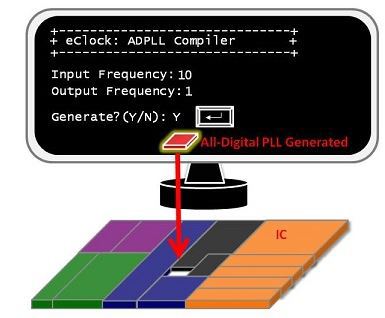
網頁:http://www.ee.nthu.edu.tw/~syhuang
知識匯:https://khub.nthu.edu.tw/researcherProfile?uuid=2FD3B310-96B4-4D00-9A76-A569141F7F2F
鄭 傑教授研究室
鄭 傑 教授
學術專長領域:
Current research interests–賽局論 (game theory) 、網路科學 (network science)、光排隊理論 (optical queueing theory)
Past research interests–高速交換機 (high-speed switching)、訊息理論 (information theory)、無線通訊 (wireless communications)
1. 賽局論 (game theory):
賽局論之父馮紐曼 (John von Nuemann) 為20世紀公認最偉大的天才之一,他在數學、物理、經濟學、電腦科學、以及統計學有重大貢獻,也是第二次世界大戰曼哈頓計畫的主要參與者之一。賽局論早已被廣泛應用在經濟、政治、心理、以及生物演化等許多領域,其重要性與影響力由最近這十九年的諾貝爾經濟學獎有六年 (1994, 1995, 1996, 2005, 2007, 2012) 是頒給賽局論的學者可見一斑。
最近十多年來賽局論更被應用於無線通訊頻譜拍賣機制之設計、無線通訊與網路通訊資源分配機制之設計、以及智慧型電網的電費計價機制之設計。目前我們主要研究方向是在探討各種平衡概念,其中包括著名的Nash平衡 (Nash equilibrium),並針對各種不同的賽局設計適合的真實機制 (truthfulness mechanism design)。
2. 網路科學 (network science):
網路科學是近年來興起的一項熱門研究課題,參與這個研究課題的研究學者來自許多不同的領域,有物理學家、社會學家、心理學家、經濟學家、生物學家、數學家、電機工程學家、以及電腦科學家,並且在科學與工程方面最頂尖的期刊Nature 和Science已刊登多篇這個研究課題的論文,部份重要論文甚至被引用高達上萬次。因此,此一新興且重要的研究領域值得台灣學界對其投注關心的目光。這一個研究領域主要的焦點是大型複雜網路,含有大量的節點,例如社群網路 (即social network,常見的有Facebook、Youtube、Google+)、食物鏈 (food web)、學術引用關係網路 (citation network)、感測網路 (senser network)、以及網際網路的網頁連結 (World-Wide Web) 等等。近來許多研究結果發現大型複雜網路具有許多特異的拓樸特性,例如長尾巴 (heavy tail) 結構的分支度分佈 (degree distribution) 與高群聚係數 (clustering coefficient);同時,近似節點配對 (assortative mixing)或相異節點配對 (disassortative mixing),社群結構 (community structure) 或階層結構 (hierarchical structure) 等不同的產生網路過程,都會對複雜網路的結構造成不同的影響。
目前我們主要的研究方向是大型複雜網路的社群結構。根據觀察,大部分的大型複雜網路都有社群結構,然而要在幾萬、幾百萬、幾千萬、甚至幾億個節點中分辨出哪些節點是屬於同一個社群是一個重要且極具挑戰性的問題,我們對這個問題已提出一套有系統且嚴格的數學分析。
3. 光排隊理論 (optical queueing theory):
目前世界上並沒有光隨機存取記憶體 (optical RAM),所以目前網際網路傳送資料的方式是先儲存後傳送 (store-and-forward),亦即先將光轉換成電的形式、儲存在電子式隨機存取記憶體 (electronic RAM)、然後等到適當的時機再轉換成光的形式傳送出去,如此一來,傳送資料的速度便比全部以光來傳送資料的速度慢了很多。
目前我們主要研究方向是利用「光交換機」把光封包導引到「光纖」裡,讓光封包在光纖裡面兜圈子,等到適當的時機才將光封包導引出來,已達到儲存光封包的目的。這是目前被視為全光封包交換網路 (all-optical packet-switched network) 的一個非常重要且極具挑戰性的研究領域,未來可能全面改變目前網際網路以光電轉換儲存資料的方式,大幅提升網際網路資料傳輸的速度,對於社會的影響將會是十分巨大。
網頁:http://www.ee.nthu.edu.tw/jcheng/
知識匯:https://khub.nthu.edu.tw/researcherProfile?uuid=48A96649-9042-4242-8DA5-3DB39FA8D107
可靠計算研究室–混合訊號設計組
黃柏鈞 教授
研究興趣:利用類比/混合訊號/射頻電路設計技術,應用於有線/無線通訊系統,SoC電源管理,與生醫低電壓低功率應用。
Research Interests:Analog/Mixed Signal/RF Techniques for Wireline/Wireless Communications,SoC Power Managements,and Biomedical Low-Voltage Low-Power Applications。
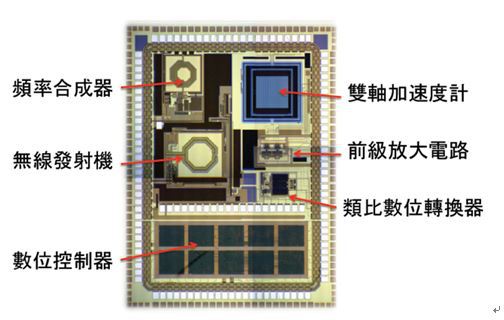
2014設計: Integrated MEMs/Mixed Signal/RF/Digital SoC
網頁:http://www.ee.nthu.edu.tw/pchuang/
知識匯:https://khub.nthu.edu.tw/researcherProfile?uuid=B432D82B-6A6B-492F-97EA-408A2B05D2EA
視訊網路研究室
林嘉文 教授
網頁:https://www.ee.nthu.edu.tw/cwlin/
知識匯:https://khub.nthu.edu.tw/researcherProfile?uuid=173F446D-C8BA-405F-B6BA-C2422EEB1158
可靠計算研究室
劉靖家 教授
我們的研究以二個主題為主,一是多核心系統層級設計和二是利用機器學習理論到電路測試和偵錯上︰
1. 多核心系統平台
利用大量平行化程式,多核心系統具有較有效利用功率的特性,但在系統設計上有許多不確定的因素,如核心數、頻寛、計算功能等都需要決定,但目前除利用架構模擬器外(必需特殊客制化),只能依靠設計人員的經驗,我們的系統平台,期望可以使用標準介面,達成各元件可相互取代,快速測試各種狀態,以完成一電子系統的架構藍圖。目前我們已完成多核CPU叢集 (cluster),晶片網路 (Network-on-Chip, NoC) ,外部記憶體等元件,可依需求加以組合變化。利用建制的系統函式庫,我們已可以執行各種平行軟體如物件追縱, JPEG壓縮,三維圖形管線rasterization等。目前我們正努力完成針對特殊計算的最佳化以及非揮發性記憶體的應用。
2. 應用機器學習理論到電路測試和偵錯
在目前測試程序日益複雜,再加上製程變異趨大的情形下,我們有必要開發新的測試方法和觀念,特別是利用應用機器學習理論處理和分析大量測試資料,以有效提昇良率。目前主要的計畫在處理系統測試的巨量資料分析。
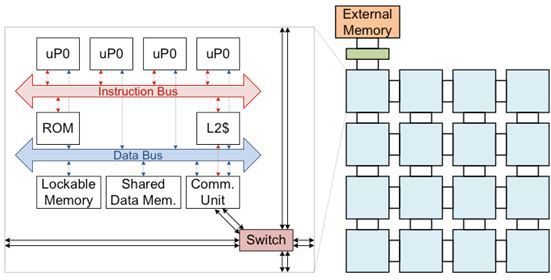
網頁:http://www.ee.nthu.edu.tw/jjliou/
知識匯:https://khub.nthu.edu.tw/researcherProfile?uuid=E5956902-885B-44CE-A107-4B2B7C2E0030
可靠計算研究室
張孟凡 教授
•奈米記憶 體積體電路設計
•低功率及 低電壓積體電路設計
•3D-IC與下世代記憶體電路設計
•記憶體系統與電路合作設計
•新奈米元件之電路設計
網頁:http://www.ee.nthu.edu.tw/~mfchang
知識匯:https://khub.nthu.edu.tw/researcherProfile?uuid=EB9DFDA7-8599-46B8-99E4-A34B79A58498
可靠計算研究室(數位系統研究室)
馬席彬 教授
Our group is working mainly on biomedical electronics applications and related signal processing. For communications, the system design, signal processing algorithm development, and SoC implementation for advanced MIMO communications and cognitive radio are still covered. Techniques related to UAV are started to be involved.
Biomedical Electronics Applications: System design, prototyping, and energy-efficient DSP processing; mobile phone sensors/apps for biomedical applications; wearable applications; interdisciplinary art team collaboration
Biomedical Signal Processing: ECG signal preprocessing, analysis, and statistics; closed-loop neural signal processing
Communication Systems and SoC Implementation: System design, performance analysis and implementation (Advanced MIMO Communications, Cognitive Radio); drone-related technologies and applications; 5G.
網頁:http://www.ee.nthu.edu.tw/~hp/
知識匯:https://khub.nthu.edu.tw/researcherProfile?uuid=77DE1567-1651-42DF-BB4E-0C7CB6FC035E
錯誤更正碼暨積體電路研究室
翁詠祿 教授
由於通訊或儲存過程常因受到外來因素影響致使發生錯誤。錯誤更正碼的功能,可把通訊或儲存過程產生的錯誤加以更正。錯誤更正碼包括:LDPC 碼、Turbo 碼、Polar碼等,不同錯誤更正碼有不同的特性,有的適合行動通訊,有的適合儲存系統。本實驗室對於錯誤更正碼的演算法及其硬體設計的研究成果豐碩,並發表於國際一流期刊;另外實驗室已成功開發Wi-MAX、Wi-Fi、10Gbps Ethernet、G.hn、SRAM、Flash memory等應用相關的錯誤更正編解碼器。目前實驗室分成系統與晶片設計組。
系統組的研究方向有:(1) 錯誤更正碼的碼建構與解碼演算法,主要是設計可應用於儲存系統以及高速有線通訊的LDPC碼,此碼需在瀑布(waterfall)區及錯誤泥沼(error floor)區兼具優異性能。(2) 應用於下一世代無線通訊系統的先進錯誤更正碼設計。(3) 錯誤更正碼在影像與生物識別(Biometric)上的應用。
晶片設計組的研究方向為:(1) 錯誤更正碼編解碼器晶片設計,如應用於儲存媒體系統低error floor、高碼率編解碼器晶片設計;應用於光纖通訊系統的超高吞吐量(100Gbps)編解碼器晶片設計。(2) 無線通訊晶片設計,如應用於第五代行動通訊可變碼率編解碼器晶片設計,MIMO通訊系統的迭代式檢測與解碼接收器的晶片設計。
知識匯:https://khub.nthu.edu.tw/researcherProfile?uuid=FA21EF13-03C8-43A7-B1C9-69C891304C09
生醫光聲影像實驗室
李夢麟 教授
生醫光聲影像實驗室主要致力於生醫超音波和光聲造影先進成像方法和系統設計的研發,並致力探索相關影像技術在生物、診斷醫學及治療上之新應用,希望能提升超音波和光聲影像在臨床和研究上的價值及解決生命科學、臨床醫學及業界所碰到的重要問題。其研究性質主要屬跨領域研究,包含理論驗證、仿體實驗、以及小動物活體實驗三部分。目前主要研究工作在於開發(1)改善光聲及超音波影像解析度、對比之超快成像技術及系統、(2) 小動物腦部功能性光聲顯微影像技術及系統、(3) 乳癌前兆微鈣化之光聲/超音波雙模造影技術及系統開發以及(4) 超音波與雷射熱燒灼手術及藥物釋放的影像導引技術。
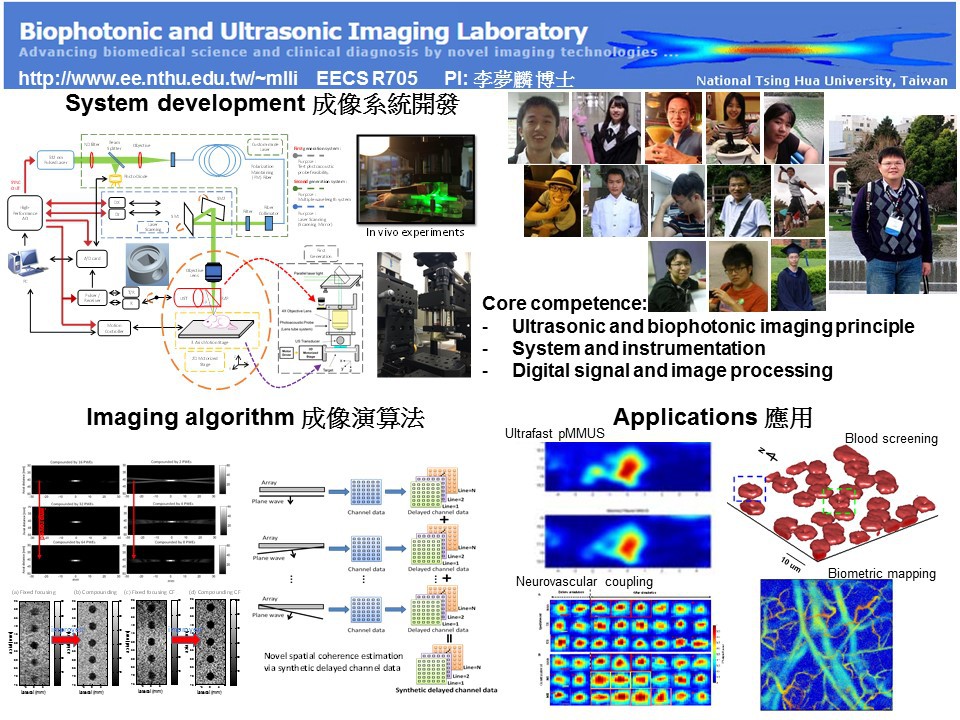
網頁:http://www.ee.nthu.edu.tw/mlli
知識匯:https://khub.nthu.edu.tw/researcherProfile?uuid=0D006BA8-7C20-4FCA-887B-299733C48809
氣體量測及材料塗佈實驗室
鄭桂忠 教授
本實驗室之設立目的為支持電機系教師進行氣體量測及材料塗佈之研究,提供感測器材料塗佈、感測器量測實驗、以及氣體感測資料處理分析的相關儀器設備。
可靠計算研究室 – 仿生與生醫工程研究室
鄭桂忠 教授
本實驗室致力於電子資訊與生命科學的整合,以類比/混合信號積體電路設計為基礎,進行二方面的研究:
(1) 仿生系統晶片,如仿生產品—電子鼻,可用於偵測空氣中的氣體分子以達到偵測與監控的目的,其所帶來的環保甚至醫療等相關效益將使人類的生活品質有所改善。
(2) 生醫系統晶片,將電路設計應用於神經刺激與訊號擷取,如人工視網膜晶片,期許對醫療上目前尚未解決的一些問題找出可行之解決方案。
網頁:http://nbme.ee.nthu.edu.tw/
知識匯:https://khub.nthu.edu.tw/researcherProfile?uuid=12B0B786-2743-44C5-8315-2CD760E17380
可靠計算研究室:訊號感測與應用研究室
謝志成 教授
訊號感測與應用研究室(SiSAL)簡介
訊號感測與應用研究室於2007年9月在清華大學電機系成立,其指導教授為謝志成博士。
本研究室成立之宗旨在於研究並發展創新的積體電路與系統應用方案,其發展領域包括了『互補式金氧半導體影像感測器電路』、『低壓低功耗類比數位轉換器』、『智慧型影像感測器設計與應用』、『類比與混合訊號電路』與『生醫應用電路與系統』等。本研究室積極參與產業界和其他研究中心的合作計畫,訂立研究方向以符合計畫需求,並透過定期交流確保實施順利。
本研究室之學群亦隸屬於『可靠計算研究室』之學術性的研究/產業/大學聯盟,我們將致力於在所學領域上創造突破性的成就。
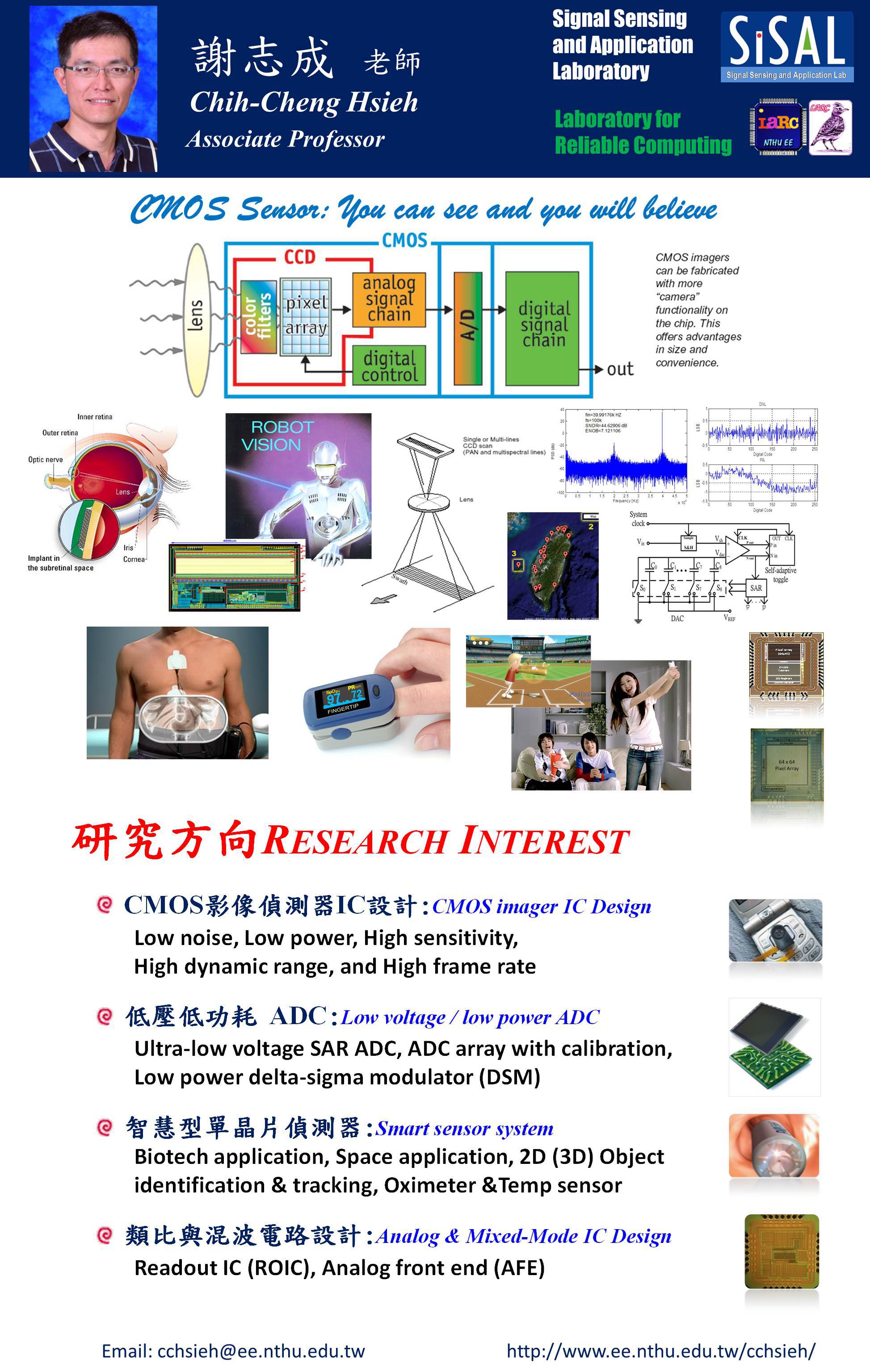
網頁:http://www.ee.nthu.edu.tw/cchsieh
知識匯:https://khub.nthu.edu.tw/researcherProfile?uuid=42DC5FEE-9746-441C-B6D1-0FB9CB101DC8
聲學與聽覺研究室
劉奕汶 教授
本實驗室歡迎各種背景的學生(含大學部學生)加入。目前研究方向包含:
1. 《聲音實境探勘》:聯網麥克風訊號處理與分析
2. 耳蝸力學與聽覺神經系統動態模擬
3. 運用仿生方法之機器聽覺
4. 耳聲傳射之理論與實測
網頁:http://www.ee.nthu.edu.tw/ywliu/
知識匯:https://khub.nthu.edu.tw/researcherProfile?uuid=B444CC7F-8355-4B0B-837E-A0ACA8FA4058
可靠計算研究室
謝秉璇 教授
Our research is focused on energy-efficient circuits and systems designs, including high-speed electrical data communications, clocking and synchronization systems, and energy harvesting systems for wireless sensor networks and machine-to-machine applications.
網頁:http://www.ee.nthu.edu.tw/phsieh/
知識匯:https://khub.nthu.edu.tw/researcherProfile?uuid=BB9C00C4-93E8-49B0-BBC0-854BE42967B8
計算機視覺電路與系統研究室
黃朝宗 教授
我們的研究專注於計算機視覺之數位電路與系統實現,特別是光場訊號處理以及計算機攝影學;研究的內容包含了演算法開發、積體電路架構設計、晶片實現、與展示平台之建立;我們的目標是在數位訊號處理能力持續增進的背景下,去思考與研究如何不斷地拓展計算機視覺應用之邊界。
網頁:http://www.ee.nthu.edu.tw/chaotsung
知識匯:https://khub.nthu.edu.tw/researcherProfile?uuid=DADB1574-523C-4912-9145-72CD69535362
人類行為訊息暨互動計算研究室
李祈均 教授
BIIC 研究室進行基礎及應用研究:著重在“人類的行為訊號處理(Behavioral Signal Processing)" 的跨學科的研究方向。 BSP是個橫跨行為科學與電資工程的研究領域。BIIC lab 目標是開發新的人類行為演算法,即行為訊息學(behavioral informatics),對人類行為訊號進行建模。這些人類行為訊號表現在顯性和隱性行為線索中,被人類無時的運用及處理,並促進對於人的分析和決策。建構的模型後再進一步運用在各人類科學領域中及發展科學相關知識。
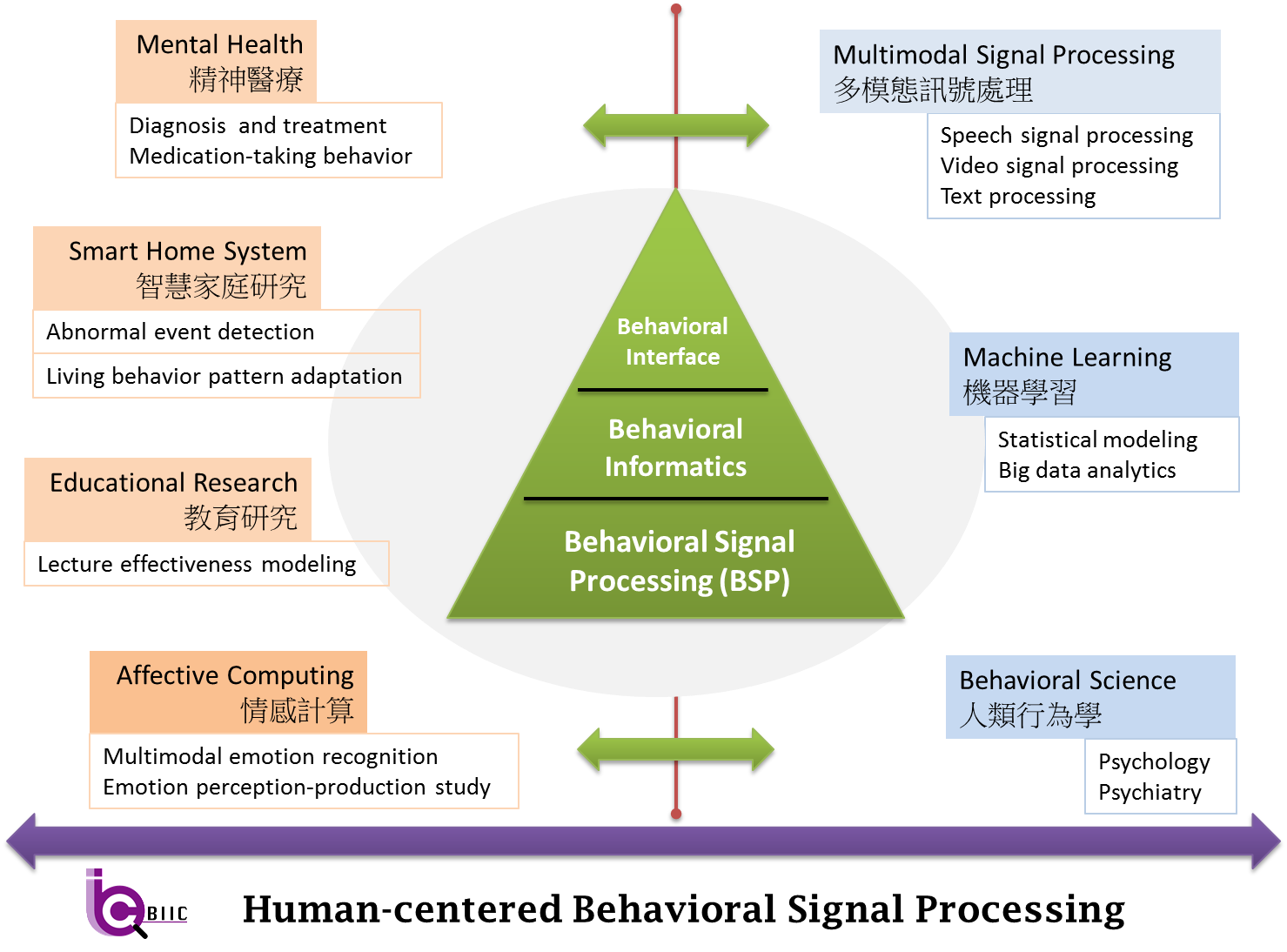
知識匯:https://khub.nthu.edu.tw/researcherProfile?uuid=82D26611-203C-41C4-8287-123E52C6DBAA
視覺科學研究室
孫 民 教授
視覺科學以及其技術在計算機視覺、機器人視覺、行動視覺等領域有許多重要影響。我目標以視覺科學為關鍵技術,建造改變遊戲規則的應用,以改善我們的日常生活。
目前,我專注在利用1. 巨量的2D/3D/4D的視覺資料(例如:照片、深度資訊、影片等)以及2. 無所不在,擷取人類行為的感測資訊(例如:目光、GPS位置、運動資訊等)去理解我們所處的世界。我認為理解人與世界互動的能力,將打開讓視覺科學改善我們的家庭生活、旅遊及運輸體驗、和工作狀態。
網頁:http://aliensunmin.github.io/
知識匯:https://khub.nthu.edu.tw/researcherProfile?uuid=7696F8CC-9336-4CDC-B361-70EA62D334D9
電腦系統與資料儲存研究室 (SSD Lab)
呂仁碩 教授
歡迎對「計算機結構與系統」有興趣的學生加入本實驗室!
研究「計算機結構與系統」會涉獵軟、硬體協同設計及跨領域技術,可培養產業界日趨重要的「π型」雙專長。
目前本實驗室的研究方向有:
1. 電腦固態儲存(例如SSDs)之結構與系統
2. 電腦主記憶體之結構與系統
3. 新興之技術,如many-core processing、in-memory processing等
網頁:http://www.ee.nthu.edu.tw/renshuo
知識匯:https://khub.nthu.edu.tw/researcherProfile?uuid=E37DAF60-062C-4B03-A8DB-94EF167F58CF
彭朋瑞教授
網頁:https://penjuipn.wixsite.com/my-site
知識匯:https://khub.nthu.edu.tw/researcherProfile?uuid=417ee259-4602-468c-ac4a-d56a4aafa4dd

